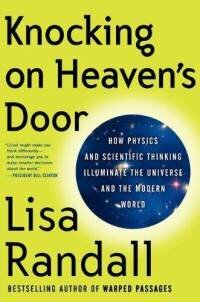
Because this is Seattle, tomorrow night, Wednesday, October 12, hundreds and hundreds of people will crowd into the Great Hall at Town Hall to hear Harvard theoretical physicist Lisa Randall talk about the Large Hadron Collider, dark matter and energy, and supersymmetry.
They’ll be paying $5 for what is essentially a stop on a book promotion tour–Randall’s Knocking on Heaven’s Door has just come out. But privately, I suspect, they’ll be hoping that, perhaps quantum mechanically, some of Randall’s smarts will leak out and up their IQ.
For those of you wondering what the Large Hadron Collider has been up to recently, this is can’t-miss stuff, and by that I mean both Randall’s talk and her new book. Knocking on Heaven’s Door is, at 417 pages of science narrative (excluding end notes and such), going to cover much more ground than Randall can in her talk. (Which should go something like this.) Also, Knocking on Heaven’s Door contains this XKCD comic on string theory. Very hip.
Part of the reason that KOHD is 417 pages is because Randall, quixotically, has decided to explain how science works for the benefit of anyone near the back. In her first chapter, she lays the groundwork with the question of scales (confusion arising from the misapplication of scale is at the heart of a lot of New Age woo regarding thinking quantum mechanically). Newton’s physics, for instance, aren’t wrong so much as limited in the scales at which it can be applied. But many other theories are wrong, in whatever scale you care to choose to test them in.
In Chapter Two, you get a lot of Galileo. Chapter Three concludes: “The religious part of your brain cannot act at the same time as the scientific one. They are simply incompatible.” Another three chapters whiz by as Randall dives deeper into the world of very, very tiny particles, and introduces you to the Higgs mechanism, which is the original How the Leopard Got His Spots tale, except in this case the Leopard is particles and the Spots are mass.
The idea–whatever we call it–is that a phase transition (perhaps like the phase transition of liquid water bubbling into gaseous steam) took place that actually changed the nature of the universe. Whereas early on, particles had no mass and zipped around at the speed of light, later on–after this phase transition involving the so-called Higgs field–particles had masses and traveled more slowly.
 The Large Hadron Collider (LHC) will no doubt produce a lot of evidence, but one thing in particular that theoretical types have predicted is the existence of a Higgs boson, which would follow from there being a Higgs field. It may also tell us why the masses particles do have are much less than is theoretically predicted by quantum mechanics.
The Large Hadron Collider (LHC) will no doubt produce a lot of evidence, but one thing in particular that theoretical types have predicted is the existence of a Higgs boson, which would follow from there being a Higgs field. It may also tell us why the masses particles do have are much less than is theoretically predicted by quantum mechanics.
Randall takes you inside the LHC, both literally and figuratively, discussing the political machinations behind its construction and giving a history of particle collision, and in the process explaining why the LHC is so powerful that some people (again, a little misunderstanding of scale) were under the impression that it might create a black hole that would swallow all life as we know it. In fact, it may well create a black hole, or a whole fleet of them, but they wouldn’t manage to swallow a gnat because they would be very, very tiny.
The thing to worry about with the LHC is that it uses enough electricity to power a small city and when things go wrong, it gets very expensive in short order.
Somewhere around page 250 the micro-particle going gets difficult to take seriously. A sample illustration caption reads, in Alice-in-Wonderland fashion: “The W boson can decay into a charged lepton and its associated neutrino, or into an up and down quark, or a charm and strange quark.” You’ll soon meet Murray Gell-Mann, and nothing will ever seem certain, or clear, again.
On page 285, deep in an explanation of the Higgs mechanism and boson, Randall writes, deadpan, “This was a difficult section with several abstract concepts,” and then she summarizes, briefly, all the stuff you didn’t grasp at length. When, a few pages later, she asks you to recall that “taus are the heaviest of the three types of charged leptons and are the heaviest particles aside from bottom quarks that a Higgs boson can decay into,” you may simply smile agreeably and hope it won’t be on the test.
Chapter Seventeen moves on from the LHC, to what’s next: supersymmetry, dark matter, and extra dimensions. Supersymmetry is an attempt to solve that discrepancy in the masses that particles have (observed vs. predicted), by inventing a whole new set of symmetrical particles. String theory, in contrast, suggests that open strings are “anchored to a brane.” If there are different branes “out there,” gravity could exist on another one, and this would help explain its relative weakness, compared to other forces.
And then there’s dark energy and dark matter. Google it. Randall’s concern here is to explain how we might be able to find evidence of these mysterious things, which ought to be there, but don’t seem to interact with other energy and matter in ways that we can so far detect. Interactions could be rare, or hard to see, or both.
For the layperson, paradoxically perhaps, Randall’s attempt to elucidate what exactly scientists are up to in particle physics and cosmology could have the effect of emphasizing the inscrutability of what the eggheads are up to in their dark caverns underground. KOHD feels much like the kind of book that people buy to display bona fides via bookshelf, with a subset actually cracking it open, and a subset of them actually finishing that Higgs bestiary.
The Heisenberg’s Uncertainty Principle, probability of flavor matter / antimatter changing within a neutrino system, and variable unknown masses of the neutrinos could have resulted the recent conclusion of FTL in laboratory experiments.
Bottom line, they have not found the higgs-boson particle and they won’t. Prior to LHC, Higgs theory was scoffed at. $20 billion later, no particle and according to Indian scientist, they have less than 5% chance finding it. Liberals trying to prove no god esists.. wasted $20B and what did the people get fro this money? higher taxes!!
Zap Sters said they have not found the higgs-boson particle and they wont. I disagree, and Lisa most elegantly provides explainations of why the LHC is not there yet. It still has lots of trials to make, at higher energy levels and intensities of collisions. But the theeoretical physics does predict the Higgs field or a very similar field to give mass to particals to prevent the other non-real predictions. So its a matter of time to find it. They are just starting and the LHC should have eht energy to do it. As to the God reference, thats really off topic. Lisa Randal addresses it easily and puts it aside. Read the book and actually learn something sir.
I’ll add it to my book list. Speaking of Murray Gell-Mann, I highly recommend the Quark and the Jaguar. He introduces complex adaptive systems, and after reading the book you’ll seem them everywhere and imagine how to change them (government, for instance).